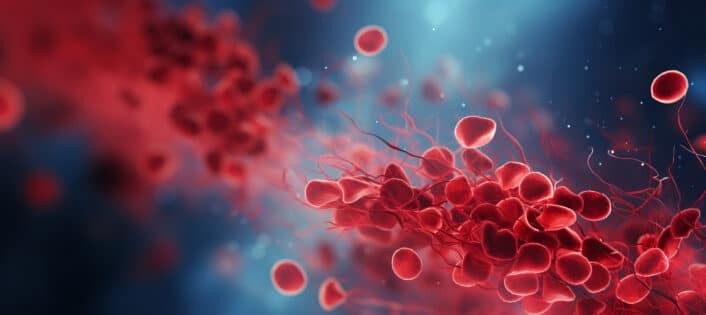

Disclaimer: This article is for informational purposes only and is not intended to diagnose any conditions. LifeDNA does not provide diagnostic services for any conditions mentioned in this or any other article.
Hemoglobin (Hb) is a vital protein found in red blood cells, responsible for transporting oxygen (O₂) from the lungs to the rest of the body and returning carbon dioxide (CO₂) from the tissues back to the lungs. It has four globin subunits, each containing a heme moiety with an iron atom that can bind to one oxygen molecule, allowing hemoglobin to carry up to four oxygen molecules simultaneously. This iron component gives red blood cells their distinctive red color.
Hemoglobin plays a vital role in oxygen transport. It maintains the shape of red blood cells, ensuring they can move efficiently through blood vessels. Abnormal levels or forms of hemoglobin can lead to various medical conditions, highlighting its importance in overall health and proper bodily function.
Fetal hemoglobin (HbF) is a type of hemoglobin found predominantly in fetuses and newborns. It differs from adult hemoglobin (HbA) in its structure, consisting of two alpha and two gamma globin chains (α2γ2), as opposed to the two alpha and two beta chains (α2β2) found in HbA. This structural difference gives HbF a higher affinity for oxygen than HbA, crucial for efficient oxygen transfer from the mother’s blood to the fetus.
HbF levels are highest in the fetus and begin to decline after birth, being gradually replaced by HbA. In certain medical conditions, such as sickle cell disease and beta-thalassemia, higher levels of HbF can lessen symptoms by compensating for defective adult hemoglobin. Researchers are exploring ways to increase HbF levels therapeutically to treat these hemoglobinopathies.
Hemoglobin levels are a crucial indicator of overall health, reflecting the body’s capacity to carry oxygen to tissues. High Hb levels can indicate conditions such as polycythemia vera, lung disease, or may be a result of living at high altitudes. On the other hand, low levels often signal anemia, which can result from deficiencies in iron, cobalamin (vitamin B12), or folate (vitamin B9). Also chronic diseases, or bone marrow problems can contribute to low Hb levels
For athletes, hemoglobin levels are critical as they affect endurance and performance. Additionally, monitoring Hb is crucial for individuals with chronic illnesses or those undergoing treatments like chemotherapy. Regular testing helps in early detection and management of potential health issues, ensuring timely medical intervention when necessary.
The normal hemoglobin range in blood varies by age, sex, and physiological conditions. For adult men, the typical range is approximately 13.8 to 17.2 grams per deciliter (g/dL), while for adult women, it is about 12.1 to 15.1 g/dL. Children have varying normal ranges, depending on their age, from 11 to 16 g/dL. Pregnant women usually have slightly lower hemoglobin levels, with regular ranges adjusted to account for the increased blood volume during pregnancy, typically around 11 to 12 g/dL.
Healthcare providers use these ranges as crucial benchmarks to assess and monitor an individual’s health, diagnose conditions like anemia or polycythemia, and guide treatment plans accordingly.
Hemoglobin blood concentration results from genetic variations and non-genetic factors like nutrition, sex, age, and altitude. The genetic diversity influencing Hb is complex and varies significantly among populations.
Variants that cause abnormal Hb or affect erythrocyte characteristics increase the risk of anemia, especially the inherited globin abnormalities that disrupt Hb production and structure. High frequencies of such variants are found in malaria-endemic regions, posing significant public health challenges due to their link to non-nutritional anemia. Variations in genes related to some enzymes and membrane proteins also affect erythrocyte lifespan and anemia risk, though most are rare. Genetic differences can influence various hematological parameters, including Hb production, erythropoiesis, and iron metabolism.
A 2015 genome-wide association study (GWAS) identified a total of 23 associations at ten genetic loci. Five associations were in previously undetected loci harbouring genes MPHOSPH9, PLTP-PCIF1, ZFPM1 (FOG1), NFIX, and CCND3. Previously discovered loci included genes in the alpha and beta-globin gene clusters.
The HBB, HBA1, and HBA2 genes have numerous indel SNPs and less prevalent point mutations that are linked to hemoglobin (Hb). The β-globin (HBB) gene on chromosome 11 exhibits a greater number of variants compared to the α-subunit (HBA1, HBA2) genes. Mutations in these genes can lead to several types of hemoglobinopathies, some of which are detailed below.
Caused by a point mutation in the HBB gene (a substitution of adenine with thymine at the sixth codon), sickle cell anemia leads to the production of abnormal hemoglobin known as hemoglobin S (HbS). The SNP (rs334) causes red blood cells to deform into a sickle shape, leading to complications such as pain, anemia, and organ damage. This variant is especially prevalent in malaria-endemic regions since it provides protection from malaria.
In thalassemia, the genes encoding the globin chains of hemoglobin are affected. Hemoglobin E (HbE) is the most common form of variation in the HBB gene, with HBB: c.79G>A (rs33950507) as the best known variant. It is involved in beta-thalassemia and also provides protection from malaria. The thalassemias result from mutations that reduce or eliminate the production of the globin chains. The affected genes in alpha-thalassemia are HBA1 and HBA2, which encode the alpha-globin subunits. Mutations in these genes reduce alpha-globin chain production, leading to an imbalance in the globin chain ratio and ineffective erythropoiesis and hemolysis.
Pregnant women require higher iron intake to support increased blood volume and fetal growth. Low hemoglobin can lead to symptoms like fatigue, weakness, shortness of breath, and, in severe cases, complications such as preterm delivery, low birth weight, and developmental issues in the baby.
Pregnant women must have regular prenatal check-ups to monitor their hemoglobin levels. Treatment typically includes iron and folate supplements along with dietary adjustments to ensure sufficient iron intake to maintain normal hemoglobin levels. Proper management helps maintain maternal health and supports optimal fetal development.
Hemoglobin levels can exhibit minor fluctuations daily due to various factors, but significant changes are uncommon without underlying health conditions. Factors contributing to daily variations include hydration status, physical activity, and minor dietary changes. Dehydration can falsely elevate hemoglobin levels, while overhydration might dilute them.
Exercise can temporarily increase levels due to the release of red blood cells from the spleen. However, these fluctuations are usually within a normal range and not clinically significant. A healthcare provider should evaluate to rule out conditions like anemia or polycythemia and to ensure appropriate medical management.
Checking hemoglobin levels at home has become more accessible with home testing kits and portable devices. These kits typically involve a finger-prick blood test, where a small drop of blood is placed on a test strip and inserted into a hemoglobin meter. The device then provides a reading of the hemoglobin level within minutes.
Some advanced digital devices may also measure other parameters like hematocrit. For accurate results, follow the instructions carefully and calibrate the device. While home tests can offer convenient monitoring, they should not replace regular medical check-ups and professional laboratory tests for comprehensive health assessment.
Improving hemoglobin levels involves dietary and lifestyle changes. Incorporating iron-rich foods like red meat, poultry, fish, lentils, beans, and spinach into your diet is essential. Vitamin C enhances iron absorption, so consuming citrus fruits, berries, and bell peppers alongside iron-rich foods is beneficial. Folate (B9) and cobalamin (B12)are also crucial for hemoglobin, obtainable from foods like eggs, dairy products, and leafy greens.
Staying hydrated is essential, as proper hydration helps maintain optimal blood volume and hemoglobin concentration. Regular physical activity stimulates red blood cell production. Avoiding substances that inhibit iron absorption, such as excessive caffeine and calcium, can also help. If dietary changes are insufficient, consulting a healthcare provider for appropriate supplements is advisable.


